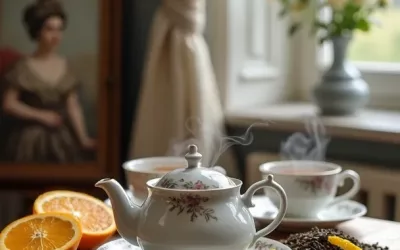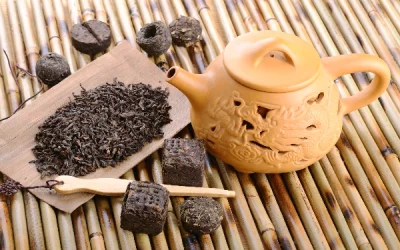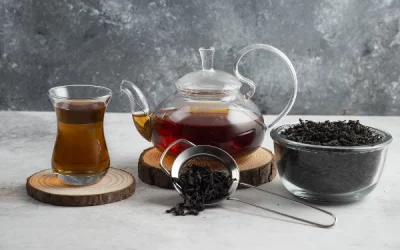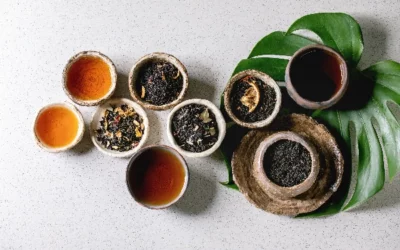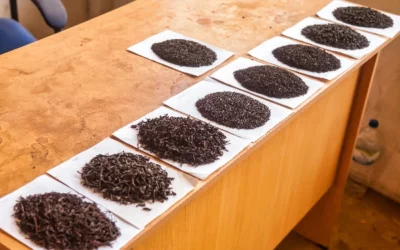Welcome, tea enthusiasts! If you’ve ever wondered how to brew the perfect cup of black tea, you’re in for a delightful journey. In this comprehensive guide, I will walk you through the basics of black tea, from its rich origins and various types to its health benefits. You’ll learn how to choose the right tea leaves, understand the significance of water quality, and master the art of steeping. Plus, I’ll share customisation options to tailor your brew to your taste. Whether you’re a beginner or a seasoned tea lover, immerse yourself in the world of black tea recipes that will elevate your sipping experience. Let’s dive in!
Table of Content
- What are the basics of black tea?
- How to choose the right tea leaves?
- What is the ideal water temperature and quality for brewing black tea?
- How long should you steep black tea?
- What are the best practices for customising black tea?
- How to store black tea for optimal freshness?
- How does black tea compare to other types of tea?
- What are some popular black tea recipes?
- Conclusion
- Resources
What are the basics of black tea?
Black tea stands out as one of the world’s most cherished beverages. It’s known for its robust flavour, deep colour, and cultural significance. Understanding black tea begins with knowing where it comes from, how it’s processed, the different types available, its caffeine kick, and its numerous health benefits. So, let’s dive right in!
Black tea has various types, each with its unique characteristics. Most black teas come from the Camellia sinensis plant, but their distinctive flavours result from different processing methods and plant varieties. Originating from regions like China, India, Sri Lanka, and Africa, black tea tells a story of rich tradition and meticulous craft. Caffeine levels in black tea tend to be higher than those in green tea, making it a great choice for that much-needed morning pick-me-up. Moreover, numerous studies highlight its potential health benefits, from improving mental alertness to reducing the risk of chronic diseases.
What are the different types of black tea?
This tea, truly fascinating, comes in several different types black. Each type has its own unique flavour profile and origin. Here’s a look at some popular ones:
- Assam: Hails from India’s Assam region. Known for its full-bodied and malty flavour.
- Darjeeling: Named after the region in India, often referred to as the “Champagne of Teas.” It has a light, floral taste.
- Ceylon: Comes from Sri Lanka. Its flavour ranges from bold to citrous, depending on the area of the island it’s grown.
- Keemun: Originates from China. It offers a smoky or slightly fruity flavour.
- Lapsang Souchong: Another Chinese tea. It’s famously smoky, thanks to its unique drying process over pine wood fires.
These varieties illustrate the rich diversity of black tea. Each has its unique attributes, influenced by soil, climate, and processing techniques.
How is black tea processed?
The process of making black tea is an art that involves several key steps. These steps transform the fresh leaves from the Camellia sinensis plant into the tea that so many love. The process generally includes:
- Withering: Tea leaves are spread out to reduce moisture.
- Rolling: Leaves are twisted and rolled to release their juices.
- Oxidising: Leaves are left to interact with oxygen, darkening the leaves and enriching their flavour.
- Firing: Leaves are dried to halt oxidation and lock in the flavour.
- Sorting: Leaves are graded by size and quality.
This intricate process gives black tea its distinct appearance and robust taste. The degree of oxidation, in particular, plays a crucial role in developing the tea’s flavour and colour.
What are the health benefits of black tea?
Drinking black tea is not just a treat for your taste buds; it can be beneficial for your health as well. Here are some advantages worth noting:
- Boosts heart health: Contains flavonoids which may help to reduce the risk of heart disease.
- Improves mental alertness: Thanks to its caffeine content.
- Aids in digestion: Can support digestive health by promoting the growth of good gut bacteria.
- Rich in antioxidants: Helps to combat free radicals and reduce inflammation.
- May lower blood sugar levels: Some studies suggest it helps in managing blood sugar levels.
Adding black tea to your daily routine might provide various health perks, enhancing both your physical and mental well-being.
In 17th century England, tea was more than a beverage; it was a symbol of sophistication and good manners. When tea was first introduced, it was sold in coffee houses and was so precious that people kept it under lock and key. Black tea quickly became fashionable, leading to the famous afternoon tea custom that persists to this day. Catherine of Braganza, the Portuguese wife of King Charles II, loved tea and made it popular among the English aristocracy. Her influence engrained tea deeply into British culture, a tradition that continues to define British social life.
I remember my first experience brewing black tea – it was during a rainy day, much like you’d imagine in a classic British countryside setting. I felt a sense of peace as I watched the dried leaves unfurl in the hot water, releasing their rich, dark aroma. That fragrant, steaming cup was my introduction to black tea, and it was love at first sip. Sharing that moment with friends, we explored the variety and depths of different black teas, creating our own little rituals around the process. Each cup tells its own story, just like each type of black tea brings a unique experience to the table.
How to choose the right tea leaves?
To brew a perfect cup of black tea, selecting the right leaves is vital. High-quality tea leaves can make a significant difference in the taste and aroma of your tea. It’s not just about picking any tea leaves; you need to understand their origin, flavour profile, and even the ideal brewing conditions to get the best out of them.
The table below summarises various types of tea leaves, their origin, and their characteristics. By understanding these details, you can select the right type of tea leaves for your perfect cup of black tea.
| Type of Tea Leaves | Origin | Flavour Profile | Brewing Temperature | Steeping Time |
|---|---|---|---|---|
| Assam | India – Assam region | Strong, malty | 90-95°C | 3-5 minutes |
| Darjeeling | India – Darjeeling | Light, floral, musky | 85-90°C | 3-4 minutes |
| Ceylon | Sri Lanka | Bright, citrusy | 95°C | 4-5 minutes |
| Keemun | China – Qimen County | Smooth, slightly smoky | 85-90°C | 4-5 minutes |
| Lapsang Souchong | China – Fujian | Smoky, pine | 90-95°C | 2-3 minutes |
| Yunnan | China – Yunnan | Earthy, spicy | 90-95°C | 3-4 minutes |
| Nilgiri | India – Nilgiri Hills | Fragrant, brisk | 90-95°C | 4-5 minutes |
This table is a handy guide:
- The first column lists the type of tea leaves.
- The second column shows where the tea originates.
- The third column describes the flavour profile of the tea.
- The fourth column provides the ideal brewing temperature.
- The fifth column indicates the optimal steeping time.
By referring to this table, you can customise your black tea experience based on your taste preferences.
What should you consider when selecting tea leaves?
Choosing the right tea leaves involves a few key considerations. Let’s break these down:
- Tea Origin: The place where tea is grown affects its flavour and aroma. Different regions produce tea with unique characteristics.
- Flavour Profile: Know your taste preferences. Some teas are strong and robust, while others are light and delicate.
- Brewing Conditions: Follow the suggested brewing temperature and steeping time to extract the best flavours.
- Leaf Grade: Higher grade leaves usually indicate better quality and taste.
- Freshness: Always check for the freshness of the tea. Stale tea leaves can lose their aroma and flavour.
Here’s what you should keep in mind:
- Explore teas from renowned tea-growing regions like Assam, Darjeeling, and Ceylon.
- Identify the flavour profile that suits your palate.
- Pay attention to brewing instructions for each type of tea.
- Opt for loose leaf or whole leaf teas for a richer experience.
- Store your tea in airtight containers to maintain freshness.
With these considerations, you can make an informed choice and enjoy a delightful cup of black tea.
How to brew the perfect cup of black tea?
Brewing a perfect cup of black tea is an art. The right technique brings out the best flavours. Here’s how you can do it:
- Measure the Tea Leaves: Use 1 teaspoon per cup.
- Boil Water: Heat your water to the recommended temperature.
- Steep Time: Let the tea steep for the specified time.
- Strain the Leaves: Use a strainer to remove the tea leaves.
- Serve: Pour the tea into your cup and enjoy.
Here’s a step-by-step breakdown:
- Heat water to the recommended temperature (usually between 85°C and 95°C).
- Use 1 teaspoon of tea leaves per cup of water.
- Steep the tea for the specified time, usually 3-5 minutes, depending on the type.
- Strain the tea leaves before serving.
- Serve your tea plain, or with milk, sugar, or lemon to taste.
Following these steps ensures the perfect extraction of flavours, making your tea experience enjoyable and satisfying.
In ancient China, tea was more than just a beverage; it played a significant role in social and cultural practices. During the Tang Dynasty, tea became a symbol of the aristocracy. Lu Yu, often referred to as the “Sage of Tea,” documented these customs in his book “The Classic of Tea.” He emphasised the importance of using high-quality leaves and the right brewing techniques to create the perfect cup.
I remember the first time I tried brewing black tea. I was overwhelmed by the choices available. I decided to go with Darjeeling tea, known for its unique floral aroma. I carefully followed the brewing instructions, and the result was a cup of tea that was light and refreshing. It was an eye-opening experience that made me appreciate the nuances in tea flavours and the importance of selecting the right leaves.
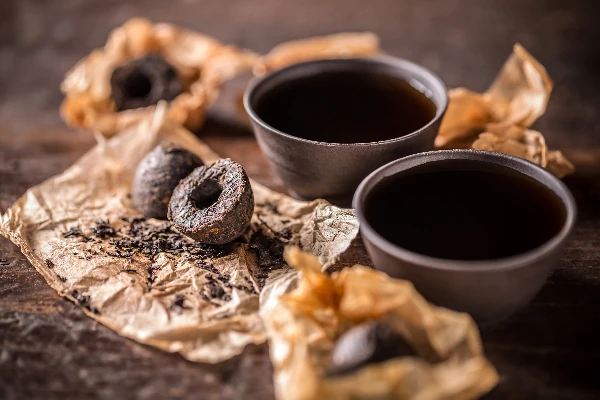
What is the ideal water temperature and quality for brewing black tea?
Okay, let’s dive headfirst into this steaming cup of knowledge. We’re tackling water temperature and quality here, which are the silent heroes behind every perfect cup of black tea. Trust me; you don’t want to mess this up. Your tea’s fate lies in the combination of these two elements – get them wrong, and you might as well be sipping on soggy cardboard.
So, what’s the catch with water temperature? Well, it can really make or break your brew. Go too hot, and you’re looking at bitterness central; too cold, and you’re left with something that tastes like sad water with a hint of leaves. Quality-wise, if you’re brewing with the sparkling essence of your municipal tap, you could be introducing delightful flavours of chlorine and metal into your sacred cup. Yummy, right?
What is the ideal water temperature for black tea?
If you think you can just boil water and be done with it, think again.
- Black tea needs water that’s hot but not Mount Doom lava hot.
- Aim for 90°C to 95°C, which is just shy of boiling (not Everest base camp freezing my friend).
- Boiling point can be slightly different at high altitudes; be mindful if you’re up a mountain.
- Too hot, and you’ll ‘burn’ the tea leaves; too cool, and you won’t extract the full flavour.
- Using a good ol’ kitchen thermometer isn’t a bad idea; it prevents catastrophes.
Yes, it’s a science. Pretend you’re in a lab, but the experiment tastes better.
How does water quality affect the flavour of black tea?
If your water quality is dodgy, even the finest tea leaves can end up tasting like a wet sock.
- Minerals in water can interact with the tea, altering its flavour.
- Hard water with high calcium or magnesium content can produce a dull taste.
- Chlorinated water? Just say no. Chlorine’s not something you want in your tea.
- Low-quality water can flatten the flavour profile and leave a strange aftertaste.
- Conversely, good-quality water highlights the nuanced flavours and complex aromas of the tea.
Moral of the story: Treat your leaves right, and they’ll treat you right back.
What types of water are recommended for brewing black tea?
Now that we’ve scared you off tap water, let’s talk about the good stuff.
- Filtered water: Removes chlorine and other nasties while retaining beneficial minerals.
- Bottled spring water: Natural minerals can enhance the flavour without overpowering it.
- Distilled water: Avoid this one – zero minerals can make the tea taste flat.
- Reverse osmosis water: Another no-go for the same reason as distilled.
- If in doubt, invest in a high-quality water filter; your taste buds will thank you.
To put it simply, if you wouldn’t drink the water straight, don’t let it anywhere near your tea leaves.
Back in the day, in 2737 BC to be exact, a Chinese emperor named Shen Nong discovered tea by sheer accident. Legend has it that while he was boiling water under a tree, some leaves blew into the pot. Curiosity piqued, he took a sip and voila! The delightful beverage we know as tea was born. Imagine if that water had been anything less than pure – Emperor Shen Nong might have gagged on a mouthful of bitter brew, and we’d all be drinking… who knows what. Cheers to water done right!
How long should you steep black tea?
Alright, let’s cut to the chase. Black tea doesn’t deserve less attention than your pet or your favourite Netflix series. Seriously! Steeping black tea requires precision. Treat it right, and it’ll thank you. How, you ask? By being ridiculously tasty and refreshing. So, let’s sip into it (pun intended).
Black tea has its quirks. Steep it for too little, and guess what? You’re drinking forgettable hot water. Steep it for too long, and you’re in for a bitter ride of regret. Achieving the perfect steep is about striking that golden balance. Allow me to enlighten you.
What is the recommended steeping time for black tea?
Black tea isn’t a “one steep fits all” situation. The rule of thumb?
- Most black teas bask in glory around 3-5 minutes.
- Darjeeling, the sophisticated diva, prefers the lower end, about 3 minutes.
- Assam, the robust brawler, likes a bit more, closer to 5 minutes.
- Lapsang Souchong, with its smoky flair, also hangs around the 4-5 minute mark.
When timing your steep, remember, it’s about dancing between time and temperature. Water that’s too hot or steeping that takes forever? No thanks.
How does steeping time affect the flavour of black tea?
You’d be surprised at how a mere minute can dictate the tea’s attitude.
- Shorter Steep (under 3 minutes): Light, subtle, almost teasing your taste buds with hints of what could be.
- Optimal Range (3-5 minutes): Balanced, flavorful, that’s the magic spot where the tea unfolds its grandeur.
- Longer Steep (over 5 minutes): Say hello to bitterness, astringency, and an overwhelming taste. Spoiling what could have been a delightful experience.
Steeping influences everything from the aroma to the aftertaste. Got a weak steeping game? Your tea’s flavour won’t forgive you.
What are the signs of over-steeping black tea?
Think you’ve mastered the steep? Not so fast. Over-steeping suicide missions are more common than you think:
- Bitter Taste: Like munching on aspirin. Awkward.
- Murky Colour: Your once golden brew now looks like a swamp.
- Astringency: The mouth-puckering sensation that screams “you messed up”.
Tips for achieving the perfect steep
Just like piloting a spaceship can be tricky, so can steeping black tea. Here’s your co-pilot checklist:
- Temp Check: Keep the water temperature between 90-100°C (194-212°F).
- Timer: Invest in a timer. Your phone works too, no tech excuses.
- Tea Quantity: Use about 1 teaspoon of tea leaves per 200 ml of water.
- Stirring: Give a gentle stir to ensure even extraction.
- Taste Test: Take a sip to check before declaring it ‘done’.
In the marvellous 18th century, Anne, Duchess of Bedford, introduced the practice of afternoon tea—a ritual of haven mid-afternoon meals accompanied by properly steeped black tea. It bridged the long gap between lunch and dinner, and tea became more than a drink; it was a gateway to social elegance and conversation.
If Royalty deemed it important enough to perfect, you should too. Brew responsibly and enjoy every cup like a prince or princess. So next time you steep, channel your inner aristocrat and pour with pride.
What are the best practices for customising black tea?
Let’s cut to the chase—everyone and their dog has a different way of drinking their black tea. And why not? Life’s too short to settle for a mediocre brew. Customising your black tea is like choosing your wardrobe; it should reflect your personal taste and mood. The beauty of black tea is its versatility. You can jazz it up with milk and sugar, spice it up with a variety of seasonings, or tweak its strength until it’s just right. So, let’s dive into the good stuff.
How can you customise black tea with milk and sugar?
First up: the classic combo. Adding milk and sugar to your black tea isn’t exactly rocket science, but there’s an art to it.
- Milk First or Tea First: There’s a raging (not really) debate on whether to pour the milk before or after the tea. Old-schoolers argue for milk first to avoid scalding, while rebels prefer tea first for better control over the taste.
- Types of Milk: Full-fat for a creamy richness, semi-skimmed for a lighter touch, or plant-based options if you’re feeling fancy or lactose intolerant. Almond, oat, and soy milk are popular alternatives.
- Sugars and Sweeteners: Go beyond white sugar. Try brown sugar for a caramelised edge, honey for a floral undertone, or stevia if you want sweetness minus the calories.
- Simple Syrup: If granulated sugar doesn’t dissolve well enough, consider using a simple syrup for a more seamless integration into your tea.
- Pro Tip: Warm the milk slightly before adding it to the tea. This avoids an unpleasant cooling effect and blends more smoothly.
The key here is balance—too much milk drowns the tea, too much sugar overpowers it. Go easy until you find your sweet spot.
What spices can be added to black tea for flavour?
Spice things up! Literally. Infusing your black tea with spices can turn a mundane cup into an exotic experience. Here are some spice rack staples that work wonders:
- Cinnamon: Adds a sweet, woody aroma. Bagged cinnamon or cinnamon sticks both work.
- Cardamom: Offers a hint of citrus and floral. Ground cardamom or cracked pods are both used.
- Cloves: Adds a warm, slightly bitter note and works well in moderation.
- Ginger: Fresh ginger gives a spicy kick; powdered ginger offers a milder touch.
- Nutmeg: Earthy and sweet, but use sparingly—this spice can easily dominate the cup.
- Star Anise: Provides a licorice-like flavour, giving your tea a bold twist.
- Black Pepper: Sounds odd, but a tiny pinch can elevate the flavour profile without making it overpoweringly spicy.
Experiment by adding these spices directly to your brew or pre-infusing them in hot water.
How can you adjust the strength of black tea?
Strength matters. Whether you prefer your tea to punch you in the face or gently caress your taste buds, adjusting the strength of black tea is as customisable as your morning bat signal.
- Steeping Time: The longer the steep, the stronger the tea. Typically, 3–5 minutes is the sweet spot.
- Tea-to-Water Ratio: More tea leaves equal a stronger brew. A good starting point is 1 teaspoon of tea per 8-ounce cup of water.
- Water Temperature: Boiling water extracts more tannins, leading to a stronger, more astringent tea. Slightly cooler water offers a subtler taste.
- Tea Bags vs. Loose Leaf: Loose leaf tea usually provides a richer flavour, giving you more control over the strength.
- Multiple Steeps: For a milder cup, you can steep the same leaves multiple times, extracting less with each go.
The perfect strength varies based on personal preference and the type of black tea used, so feel free to go wild with trial and error.
In the 1700s, Catherine of Braganza, the Portuguese queen who married King Charles II, is credited with making tea popular in Britain. One day, whilst hosting a royal tea session, Catherine accidentally steeped her black tea for too long. Her fellow nobles, initially shocked by the strong brew, found themselves charmed by the intense flavour. This happy mistake revealed a new way to enjoy black tea that resonates even today. Just goes to show, sometimes the best customs come from a little experimentation.
How to store black tea for optimal freshness?
You don’t want to mess around with black tea storage. Your precious leaves deserve better than a musty corner in your pantry. Trust me, I’ve been down that road, and the only thing worse than a bad cup of tea is none at all. Keep your black tea fresh and flavourful with a few straightforward tips. Let’s dive in, yeah?
First off, if you bought that swanky loose leaf black tea, give yourself a pat on the back. But don’t forget that the right storage is key to making sure it stays as ‘swanky’ as it can be. Depending on what you do next, you could either be sipping on the elixir of life or something better fit for your compost heap. Let’s break it down.
What are the best containers for storing black tea?
Let’s start with the basics: containers. Sloppy storage gives way to sad sips.
- Airtight containers: Remember, air is your enemy. Airtight canisters, preferably made of opaque material or even metal, work wonders.
- Tin or stainless steel: These containers have none of that nasty leeching business and can keep the tea’s flavour intact. Avoid clear glass jars — that’s like putting your tea on a sunbed.
- Ceramic containers: These are stylish and practical. All the cool cats use them.
- Vacuum-sealed bags: Capture the essence of freshness like a pro. These are especially useful if you’re stocking up big time.
- Avoid plastic: Plastic can transfer odours and isn’t as effective in keeping moisture out. Plus, nobody likes a plastic-flavoured brew.
Alright, now that we’ve boxed up our options, let’s move on to where you should stash that tea.
What are the ideal storage conditions for black tea?
Once you’ve got the right container, get those conditions right to really nail it.
- Dark and cool: Light and heat are like kryptonite for black tea. Store it away from sunlight and in a cool spot. No steamy kitchens, please!
- Low humidity: Moisture is a buzzkill for tea leaves. Make sure it’s a dry place — somewhere far from any boiling pots.
- No strong odours: Tea is like a sponge; it’ll soak up any nearby scents quicker than you can say “Earl Grey”. Keep away from spices and those secret perfume stash spots.
- Consistent temperature: Fluctuations in temperature can degrade the tea’s quality. Think of it like a spa day for your tea leaves — calm and steady.
- Away from pests: You don’t want any uninvited critters. Cover those lids properly and store your containers in places less likely to be invaded by insects or rodents.
So, you’ve got the right container and a primo spot. All that’s left to discuss is how to spot if your tea’s gone rogue.
How can you tell if black tea has gone stale?
Stale tea isn’t going to poison you, but why settle? Here’s how to check if your black tea has lost its mojo.
- Dull aroma: Take a whiff — if it’s lacking that robust, fresh scent, something’s gone awry.
- Lacklustre flavour: Brew a cup. If it tastes flat or muted, that’s a big red flag.
- Discolouration: Fresh tea has a rich colour. If it looks pale or off-colour, it’s probably over the hill.
- Texture changes: Your tea leaves should be crisp and dry. If they feel like they’ve been hanging out in a sauna, that’s a bad sign.
- Expired packaging dates: Properly stored tea can last a year or more. However, it’s always good to pay attention to those little dates printed somewhere on the package.
Alright, think of this as your ultimate guide to keeping your black tea as fresh as a daisy. Follow these tips, and you’ll always have a splendid cup waiting for you.
Years ago, during the age of clipper ships, tea chests underwent rigorous handling and long voyages before reaching eager consumers. Despite the odds, preservation methods were impeccable. Tin-lined wooden chests protected tea from moisture, air, and light. Each chest’s journey from tea gardens in Asia to sitting rooms in Victorian England serves as a testament to what good storage can achieve. So, if they could maintain tea’s freshness on a months-long sea voyage, surely you can manage to keep yours perfect in the comfort of your home.
Now, off you go to brew a perfect, fresh cup of black tea, just as it was meant to be! Cheers!
How does black tea compare to other types of tea?
Ah, the wonderful world of tea! It’s vast, varied, and delightfully confusing. So, you’re wondering how black tea stacks up against the competition? Hold onto your teacups because we’re diving into a world of flavours, aromas, and caffeine levels that’ll make you the most knowledgeable tea aficionado at the next brunch.
First up, let’s tackle the heavyweight matches: black tea versus green tea and black tea versus herbal tea. Imagine it like a boxing ring, but with less sweating and more steeping.
How does black tea compare to green tea?
Alright, let’s get one thing straight: black tea and green tea are siblings, not identical twins. Both come from the Camellia sinensis plant, but the way they’re processed makes all the difference.
- Oxidation: Black tea is fully oxidised, giving it a robust, dark, and rich flavour, while green tea is lightly processed, retaining a more delicate, grassy taste.
- Colour: Black tea brews into a deep amber liquor, whereas green tea results in a more yellowish-green hue.
- Flavour Profile: Black tea can be malty, smoky, or even fruity, depending on the variety. Green tea often has a fresh, light, and sometimes slightly astringent flavour.
- Caffeine Content: Black tea typically has more caffeine than green tea but less than a cup of coffee. Think of it as the middle child of the caffeine family.
- Health Benefits: Black tea is rich in antioxidants like theaflavins, which can promote heart health. Green tea, on the other hand, is loaded with catechins, particularly EGCG, known for its cancer-fighting properties.
Both teas have their unique charm and health perks, so it really comes down to personal preference. Whether you lean towards the robustness of black tea or the subtlety of green tea, you’re in for a treat.
What are the differences between black tea and herbal tea?
Now, herbal tea isn’t technically “tea” because it doesn’t come from Camellia sinensis. It’s like comparing a Labrador to a Dachshund—related in the broadest sense, but oh so different.
- Ingredients: Black tea is 100% tea leaves, while herbal teas are essentially infusions of herbs, flowers, fruits, or spices. Think chamomile, peppermint, or rooibos.
- Caffeine Content: Black tea has caffeine; herbal teas are usually caffeine-free, making them the perfect bedtime buddy.
- Flavour Profile: Black tea can vary from smoky to sweet. Herbal teas offer a cornucopia of flavours—from calming chamomile to zesty ginger.
- Health Benefits: Black tea offers cardiovascular benefits and antioxidants. Herbal teas often come with specific health perks, like chamomile for relaxation or peppermint for digestion.
- Colour and Aroma: Black tea generally has a darker brew and a strong, enticing aroma. Herbal teas can range from pale yellow to deep red, with aromas that can be floral, fruity, or spicy.
So, if you’re after a robust, caffeinated kick, black tea is your friend. Need a calming, caffeine-free sip? Herbal tea is your go-to.
How does the caffeine content of black tea compare to other teas?
Oh, caffeine – that magical molecule that gets us through the day. But how does black tea fare against its leafy counterparts?
- Black Tea vs Green Tea: As mentioned earlier, black tea packs more of a punch. While green tea contains around 20-45 mg of caffeine per 8 oz, black tea boasts 40-70 mg.
- Black Tea vs Coffee: Coffee is the heavyweight champ with 95-200 mg per 8 oz. Black tea offers a milder caffeine jolt, which is often easier on the stomach.
- Black Tea vs Oolong Tea: Oolong is the middle child here. It has caffeine levels ranging between black and green tea, typically 37-55 mg per 8 oz.
- Black Tea vs Herbal Tea: Herbal teas are virtually caffeine-free. Perfect for those who want to avoid jitteriness altogether.
- Decaffeinated Black Tea: If you’re a caffeine-sensitive soul, fear not! Decaffeinated black tea lets you enjoy the robust flavours without the extra buzz.
In summary, if you crave a moderate caffeine lift that won’t have you bouncing off the walls, black tea strikes the perfect balance.
Did you know that Emperor Shen Nong is credited with discovering tea back in 2737 BC? Legend has it that some tea leaves accidentally blew into his pot of boiling water, creating the world’s first tea. This historic happy accident not only introduced the world to tea but also highlighted the importance of embracing unexpected discoveries. So, whether you choose black, green, or herbal tea, remember you’re sipping a bit of history with every delicious cup.
Cheers!
What are some popular black tea recipes?
Ready to dive into the world of black tea recipes? Oh, the joys of customising a cup just the way you like! Let’s break down some beloved favourites that have been brewing in kitchens for centuries. We’ve got everything from the classic traditional black tea to the trendy black tea latte and more exotic spiced variations. And hey, no pressure to like them all—but be prepared to become that annoying tea expert at the next party.
How do you make traditional black tea?
First up, traditional black tea—it’s the queen bee of the tea world. Simple, no-fuss, and oh-so-satisfying.
- Boil water: Start by getting your water to a rolling boil. Black tea needs hot water, no tepid nonsense.
- Measure the tea: One teaspoon per cup if you’re using loose leaf. For tea bags, one bag per cup will do.
- Steep time: Steep for 3-5 minutes. If you like it strong, go towards the 5-minute mark. A shorter steep keeps it mild.
- Strain and enjoy: If using loose leaves, strain them out or just remove the tea bag.
Traditional black tea is pure and straightforward. It’s like that reliable old pair of slippers you refuse to throw away—comfort in a cup.
What is the recipe for iced black tea?
When the summer heat has you melting faster than ice cream on a sidewalk, iced black tea is your best friend. Trust me, it’s one refreshing sip after another.
- Brew it strong: Make it double strength because it will get diluted by ice. If you’re using loose leaves, go for 2 teaspoons per cup.
- Sweeten it up: Add sugar or honey while it’s still hot, so it dissolves.
- Cool it off: Let it sit at room temperature for about 30 minutes.
- Ice, ice baby: Fill a glass with ice cubes and pour the tea over it.
- Add extras: Throw in some lemon slices, mint, or even a splash of fruit juice for a twist.
Iced black tea is like a cool breeze for your taste buds—rejuvenating, crisp, and oh-so-delicious!
How do you prepare a black tea latte?
Now, for the fancy, café-style experience right in your kitchen: the black tea latte. It’s basically a poshed-up version of your traditional cuppa.
- Brew the tea: Make a strong black tea using your loose leaves or tea bag.
- Milk it up: Heat up your choice of milk. Cow’s milk, almond, soy—your call. Froth it if feeling fancy.
- Sweet treat: Add sugar, honey, or a sip of vanilla extract. A dash of cinnamon or cardamom wouldn’t hurt either.
- Blend together: Mix the tea and hot milk at a 1:1 ratio. Top with froth if you’ve got it.
- Sip and savour: Kick back and enjoy your homemade masterpiece.
A black tea latte is essentially your cosy blanket in a mug—rich, comforting, and decadent.
For all you history buffs out there, here’s a nugget to chew on: Did you know that the British East India Company played a massive role in popularising black tea in Europe? Back in the 18th century, they smuggled tea plants from China to India and started extensive cultivation. This move pretty much changed the tea-drinking habits of an entire continent. Pretty rebellious, right? So, each time you sip on that cup of black tea, you’re partaking in a tradition born from a bit of a heist!
Conclusion
As I reflect on the journey we’ve taken through the intricacies of brewing the perfect cup of black tea, a few key points resonate strongly. We’ve delved into the essential elements of black tea, exploring its diverse types, origins, and remarkable health benefits. The importance of selecting quality tea leaves cannot be overstated; understanding the characteristics of different varieties empowers us to make informed choices that enhance our brewing experience. Quality water is equally vital, affecting not just the flavour but the overall enjoyment of our tea, while the right steeping times are crucial to preserving the delicate balance between bitterness and richness.
Customisation is an art form; it allows us to tailor our tea to our tastes, from the comforting addition of milk and sugar to the adventurous blending of spices. Proper storage is our safeguard against time, keeping our tea fresh and flavourful for longer. Finally, comparing black tea to its green and herbal counterparts reveals not only a unique character but also highlights various health benefits that can enrich our lives.
The implications of these findings extend beyond just crafting a cup of tea. Each brew becomes a reflection of personal experience and preference, a ritual that invites moments of mindfulness in our busy lives. As I consider what lies ahead, I encourage readers to experiment with their own black tea recipes, perhaps finding a new favourite concoction that speaks to their palate.
I leave you with this thought: tea is not just a beverage; it’s an experience to be cherished. So, what will your next cup reveal about your journey with tea? As we embrace the art of brewing, may each sip inspire us to explore further, discover deeper flavours, and create connections with those we share it with. Happy brewing!


